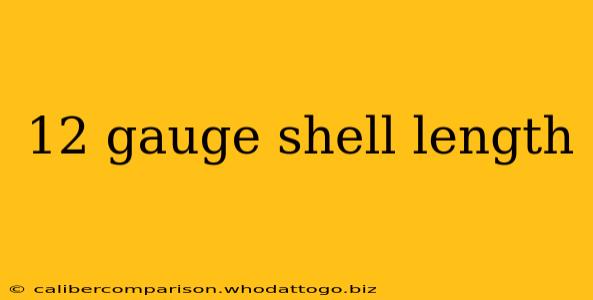The length of a 12-gauge shotgun shell is a critical factor influencing its performance and suitability for various applications. Understanding the different lengths available and their implications is crucial for both experienced shooters and those new to the sport. This guide will delve into the specifics of 12-gauge shell lengths, clarifying the common sizes and their respective uses.
Understanding 12 Gauge Shell Dimensions: More Than Just Length
While shell length is a primary consideration, it's important to understand that other dimensions play a role in overall performance. These include:
- Shell Diameter: This is consistent across all 12-gauge shells.
- Shot Charge Weight: The amount of shot contained within the shell directly impacts range and effectiveness. Larger shot charges generally mean longer effective ranges, but also increase recoil.
- Shot Size: The size of individual pellets within the shot charge impacts pattern density and lethality. Smaller shot sizes are better suited for smaller game, while larger sizes are more effective on larger targets.
- Powder Charge: The amount of gunpowder dictates the shell's velocity. Higher velocity generally leads to longer ranges, but again, increases recoil.
Common 12 Gauge Shell Lengths and Their Applications
The most commonly encountered 12-gauge shell lengths are 2 3/4 inches (70mm) and 3 inches (76mm). Let's explore each:
2 3/4 Inch (70mm) Shells: The Workhorse
The 2 3/4-inch shell is the ubiquitous standard for 12-gauge ammunition. Its versatility makes it suitable for a wide range of applications, including:
- Sporting Clays: A popular choice due to its manageable recoil and readily available load options.
- Hunting (small to medium game): Effective for birds, rabbits, squirrels, and other smaller targets, particularly with appropriate shot sizes.
- Home Defense: While viable, it might not provide the stopping power of longer shells in self-defense scenarios.
3 Inch (76mm) Shells: Increased Power and Range
The 3-inch shell offers a significant advantage in power and range compared to its shorter counterpart. This comes at the cost of increased recoil. Applications include:
- Hunting (large game): Ideal for waterfowl, turkey, deer (with slugs), and other larger targets where greater stopping power is required.
- Long-range shooting: The extra powder and shot capacity translate to improved effective range.
- Home Defense (arguably): While offering potentially greater stopping power, the increased recoil needs to be considered carefully, especially for less experienced shooters.
Other Less Common Lengths
While less prevalent, you might occasionally encounter 3 1/2-inch (89mm) magnum shells. These are typically reserved for extremely large game hunting, or specific waterfowl hunting situations requiring exceptional range and power. The recoil is significantly higher.
Choosing the Right Shell Length: Considerations for Shooters
Selecting the appropriate shell length depends entirely on your intended use. Consider the following factors:
- Target size and type: Larger game requires more stopping power, necessitating longer shells.
- Shooting distance: Longer ranges often necessitate shells with greater velocity and range.
- Recoil tolerance: Longer shells generally produce more recoil, which can be a significant factor for inexperienced shooters or those with physical limitations.
- Shotgun type: Certain shotguns might not be compatible with all shell lengths, so always check your firearm's specifications.
Conclusion: Finding the Perfect Fit for Your Needs
The length of a 12-gauge shell is a critical consideration that significantly impacts its performance. Understanding the differences between common lengths – primarily 2 3/4 inches and 3 inches – empowers shooters to choose the right ammunition for their specific application, ensuring safety and effectiveness. Always consult your firearm's manual to ensure compatibility before using any ammunition. Remember to prioritize safety and responsible firearm handling practices.

